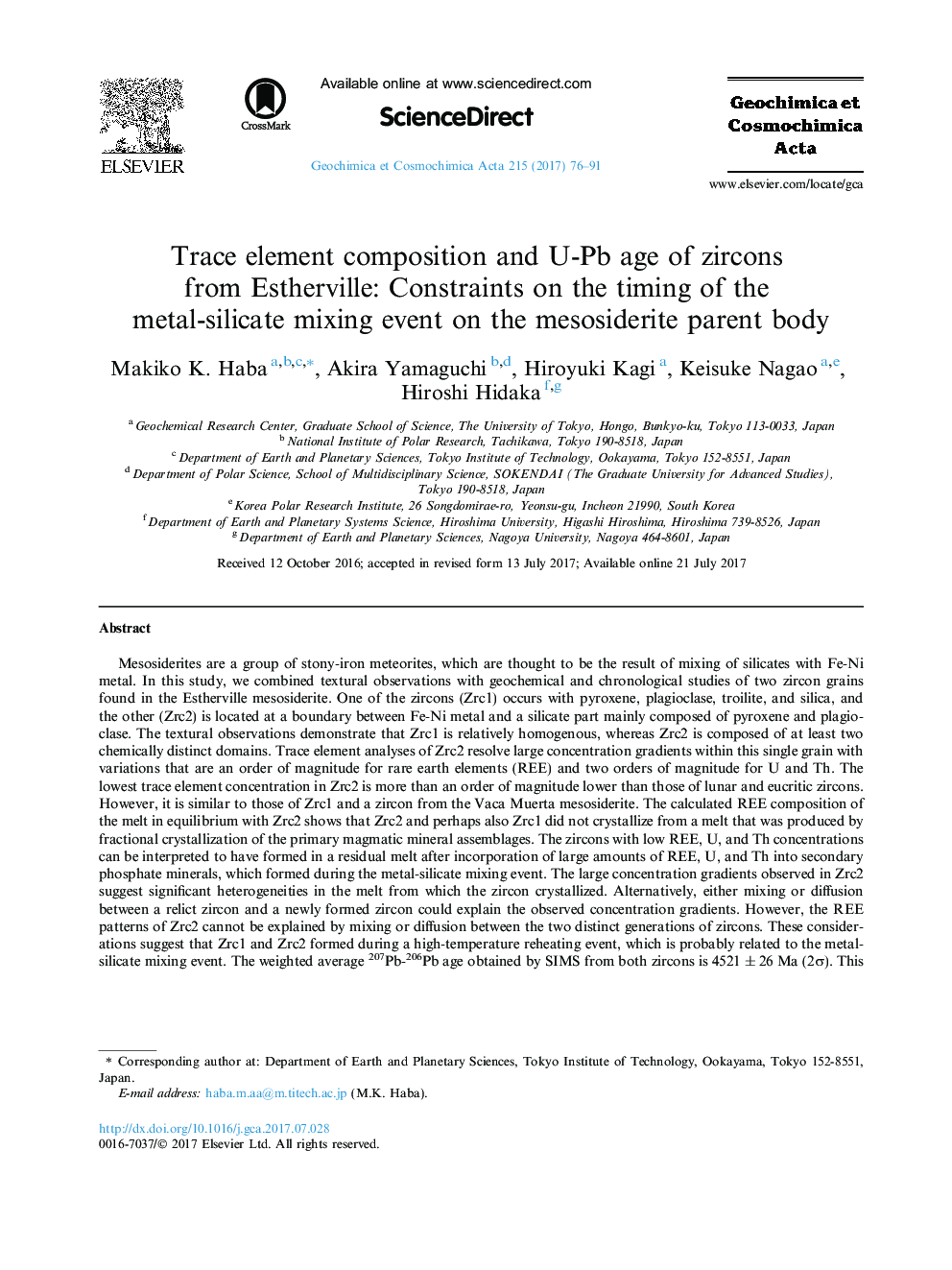| کد مقاله | کد نشریه | سال انتشار | مقاله انگلیسی | نسخه تمام متن |
|---|---|---|---|---|
| 5783234 | 1637942 | 2017 | 16 صفحه PDF | دانلود رایگان |
عنوان انگلیسی مقاله ISI
Trace element composition and U-Pb age of zircons from Estherville: Constraints on the timing of the metal-silicate mixing event on the mesosiderite parent body
دانلود مقاله + سفارش ترجمه
دانلود مقاله ISI انگلیسی
رایگان برای ایرانیان
کلمات کلیدی
موضوعات مرتبط
مهندسی و علوم پایه
علوم زمین و سیارات
ژئوشیمی و پترولوژی
پیش نمایش صفحه اول مقاله

چکیده انگلیسی
Mesosiderites are a group of stony-iron meteorites, which are thought to be the result of mixing of silicates with Fe-Ni metal. In this study, we combined textural observations with geochemical and chronological studies of two zircon grains found in the Estherville mesosiderite. One of the zircons (Zrc1) occurs with pyroxene, plagioclase, troilite, and silica, and the other (Zrc2) is located at a boundary between Fe-Ni metal and a silicate part mainly composed of pyroxene and plagioclase. The textural observations demonstrate that Zrc1 is relatively homogenous, whereas Zrc2 is composed of at least two chemically distinct domains. Trace element analyses of Zrc2 resolve large concentration gradients within this single grain with variations that are an order of magnitude for rare earth elements (REE) and two orders of magnitude for U and Th. The lowest trace element concentration in Zrc2 is more than an order of magnitude lower than those of lunar and eucritic zircons. However, it is similar to those of Zrc1 and a zircon from the Vaca Muerta mesosiderite. The calculated REE composition of the melt in equilibrium with Zrc2 shows that Zrc2 and perhaps also Zrc1 did not crystallize from a melt that was produced by fractional crystallization of the primary magmatic mineral assemblages. The zircons with low REE, U, and Th concentrations can be interpreted to have formed in a residual melt after incorporation of large amounts of REE, U, and Th into secondary phosphate minerals, which formed during the metal-silicate mixing event. The large concentration gradients observed in Zrc2 suggest significant heterogeneities in the melt from which the zircon crystallized. Alternatively, either mixing or diffusion between a relict zircon and a newly formed zircon could explain the observed concentration gradients. However, the REE patterns of Zrc2 cannot be explained by mixing or diffusion between the two distinct generations of zircons. These considerations suggest that Zrc1 and Zrc2 formed during a high-temperature reheating event, which is probably related to the metal-silicate mixing event. The weighted average 207Pb-206Pb age obtained by SIMS from both zircons is 4521 ± 26 Ma (2Ï). This age is younger than that of a primary magmatic zircon from Vaca Muerta (4563 ± 15 Ma) and probably corresponds to the timing of the metal-silicate mixing event or a later impact event.
ناشر
Database: Elsevier - ScienceDirect (ساینس دایرکت)
Journal: Geochimica et Cosmochimica Acta - Volume 215, 15 October 2017, Pages 76-91
Journal: Geochimica et Cosmochimica Acta - Volume 215, 15 October 2017, Pages 76-91
نویسندگان
Makiko K. Haba, Akira Yamaguchi, Hiroyuki Kagi, Keisuke Nagao, Hiroshi Hidaka,